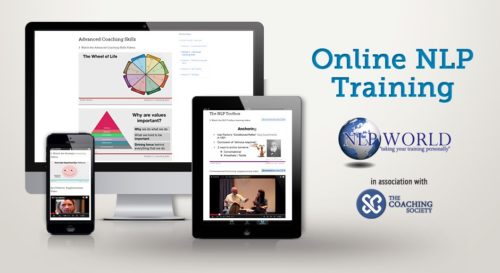How to Collapse Negative Anchors Conversationally
Terry clears an unresourceful state and collapses negative anchors conversationally (without needing to touch the client).
We not only look at conversational anchoring here, but also tactile anchoring later on.

Collapsing Anchors

All human change (All? Yes, all.) is nothing more than an integration of resources or a collapsing of realities, one into the other. The particular process of collapsing anchors involves taking a negative state, and integrating or collapsing it into a positive state. Doing this gives the person we’re dealing with more neurological choice. One of the major premises of NLP is to increase the choices a person has.
So, if we find for example that every time a certain salesperson goes out to make a sale that they become negative. It may be because they’re recalling all the times they’ve failed. If the two are linked, we can collapse the association of sales and failure, with a winning attitude, and give the salesperson the choice of feeling good about selling, too. The process of collapsing anchors will free the salesperson from the necessity of having to access the negative state every time they go out and make a sales call.
The process of collapsing anchors is one of the more powerful processes in NLP, and this technique can also be used for collapsing anchors by yourself, and it’s also easy to use. I am going to show you ONE version of conversational anchoring and ONE version of tactile or kinaesthetic anchoring. Remember there are different ways of doing this!
- Ask the person to recall a series of positive experiences, and anchor each one. Stack the anchors. For example, when they couldn’t lose, when they felt powerful, when they knew they could have it all, when they knew they could have whatever they wanted.
- If you are using conversational anchoring, you’ll have to remember what they said or did when in an intense state. The easiest way is to feed it back and then you learn it easily. If you are using tactile anchors, then have them put all the experiences, one at a time, into their right hand, while you are firing off the original anchor that you have set, with each experience.
- In conversational anchoring, have them get into a powerful state, whilst talking about the problem state. Mix up both states, so the powerful states start to be introduced to the nervous system at the same time as the negative state is being recalled. The powerful one should end up winning (if it doesn’t the powerful states were not properly set up or not powerful enough).
- If tactile, have them look at the right hand, and describe what those experiences look like. What do they say, or what do they sound like? What do they feel like? What is the shape, colour, size, sound, smell. Make a fist, now, and hold on to all those positive experiences.
- In the tactile version, now have them put the negative experience into the left hand. (f the negative experience is particularly strong, you can have the person put the negative experience into the left hand quickly without looking at it. If it’s not very strong, have them describe it as they did with the positive.) You don’t have to set an anchor for the negative experience other than the hand.
- Go back to the right hand. Have them notice those experiences again. Ask them again about some of the SubModalities, the smell, the sound, the colour, the brightness, and shape.
- Now, holding the right hand over the left hand, have them pour the positive experiences from the right hand, including the feelings and the sounds, into the left hand. Have them make a “sshhhh” (or any) noise as they do it. And have them continue pouring until the contents of both hands are the same. When both hands look, sound, and feel the same, then they can stop.
- Next, have them clap their hands together once, and then rub them together vigorously.
- Finally, have them look again and make sure that both hands are the same. If not, go back to #1.
- The negative experience in the left hand and the positive experience in the right hand will be linked in the neurology, so that the person will have more choice. The person can feel negative about the negative experience or they can feel positive about them. The negative will not have the hold over them that it had before. It’s a very powerful process, by the way, and one that you can use on yourself or others to reduce the effect of negative experiences and to create new neurological choices.
- One important caution in this process is that the NLP Practitioner should be sure that the positive anchors are stronger than the negative anchors. What you’re doing is diluting the negativity with the positively, neurologically. So it’s a neurological dilution of the negative experience. However, if the negative experience is stronger than the positive, then the positive experiences will be diluted into the negative, which is not what you want. Typically, an NLP professional will set a number of positive anchors before beginning this process, so that the negative experiences will be weaker than the positive ones. In addition, make sure that the person you’re working with is dissociated from the negative experiences. Don’t allow them to access the negative states too long, and make sure to get them out of the negative states.
- Whether you have been using your voice and body alone or touching them with tactile techniques, the theory is still the same!
Outcome
The desired outcome for this section is for all participants to be able to anchor a specific state in a person, at any time in any modality.
Theory
A. Definition: Any time a person is in an associated, intense state, if at the peak of that experience, a specific stimulus is applied, then the two will be linked neurologically
B. Anchoring can assist you in gaining access to past states and linking the past state to the present and the future.
Process
The Four Steps to Anchoring:
- Have the person recall a past vivid experience.
- Provide a specific stimulus at the peak (see chart below)
- Change the person’s state
- Set off the anchor to test.
The Five Keys to Anchoring:
- (I) Intensity of the Experience
- (T) Timing of the Anchor
- (U) Uniqueness of the Anchor
- (R) Replication of the Stimulus
- (N) Number of times
Application of an Anchor:
State Script for Tactile Anchoring
The best states to anchor are naturally occurring states. Next best are past, vivid, highly-associated states. Least preferable are constructed states.
Question to elicit the states ( + body language + eye patterns)
1st choice Q “what’s it like when you’re ………?” “How specifically?” (or any meta model questions).
2nd “Look, if you were feeling confident right now, how would you be sitting in this chair?” Look for gestures etc…maybe get them to stand up!
3rd “Can you remember a time when…?” Can you remember a specific time? As you go back to that time now … go right back to that time, float down into your body and see what you saw, hear what you heard, and really feel the feelings of being totally _______X’d______. (Can be dissociated if use this way)
States for Stacking Anchors
To stack anchors, elicit several instances of states and anchor them via recognising the body language, tone of voice and words, then feed them back to test: In tactile anchoring they would be touched in the same place. The state chosen for a particular stacked anchor can be the same or different.
Let your client come up with their own states: For instance, when you ask them “what’s it like, fishing?” You want them to let you know what the state is….. If you don’t get anything from that (rarely if you are on the ball that day), you can give them clues to states such as these below:
• A time when you felt totally powerful.
• A time when you felt totally loved.
• A time when you really felt you could have whatever you wanted, a time when you felt you couldn’t fail, when you could have it all.
• A time when you felt really energetic, when you had a ton of energy.
• A time when you fell down laughing.
• A time when you felt totally confident.
Collapse Anchors for Tactile Anchoring

1. Get into rapport with the client.
2. Tell the client what you are about to do: “In just a moment I am going to do a process called “Collapse Anchors” (explain), and that will necessitate that I touch you. Is that O.K.?”
3. Decide on which Positive/Resource States are needed, and decide on the Negative State to be collapsed. Make it clear which states specifically are involved.
4. As you elicit the Positive States get into each one before you elicit it in the
client.
5. Make sure that the client is in a fully associated, intense, congruent state for each of the states you anchor.
6. Anchor all the positive states in the same place i.e. a knuckle or other easily identifiable place.
7. Anchor the negative state once.
8. Fire anchors at the same time until they peak, and the integration is complete. (Watch the client; they will usually exhibit signs of asymmetry until the integration is complete.)
9. Release the negative anchor
10. Hold the positive anchor for 5 seconds and then release
11. Test: “Now how do feel about that old state?”
12. Future Pace: “Can you imagine a time in the future when you might be in a similar situation, and what happens?”
Chaining Anchors
Chaining is a technique that is used when the desired/resource state is significantly different from the present state.
1. Get in rapport.
2. Tell the client what you are about to do: “In just a moment I am going to do a process called ‘Chaining Anchors’ (explain), and that will necessitate that I touch you. Is that O.K.?”
3. Identify the undesirable present state (E.G.: Procrastination), and decide on the positive/resource end state (E.G.: Motivation).
4. Design the chain: Decide on what intermediate states are needed to lead to the end state.
Present Intermediate Intermediate End
State State #1 State #2 State
5. Elicit and anchor each state separately, beginning with the present state through the end state. (You may have to stack all states to get a high intensity.) Make sure that the subject is out of previous state prior to anchoring the next one. (Break State between states, especially between the last one and the first one.)
6. Test each state. Make sure that the client goes into each one.
7. Chain each state together firing #1 and when #1 is at its peak add #2, and then release #1. When #2 comes to the peak, add #3, then release #2. Add #4, etc. in the same way. (This is NOT a collapse because the two states do not peak at the same time).
8. Test: Fire present state anchor. Client should end up in final state.
9. Ask the client, “Now how do you feel about ______.” EG: How do you feel about procrastination.
10. Future Pace: “Can you think of a time in the future which if it had happened in the past you would have _________ (EG: Procrastinated) and tell me what happens instead?”
Related Content
For a deeper understanding of this subject, we recommend having a look at:
- Our NLP Glossary for the term “Anchoring“.
- Our Online NLP Practitioner Course in our NLP World Shop.
Law Of Attraction Videos
NLP World Products
-
Online Courses
Online NLP Practitioner Training
£449.00Original price was: £449.00.£149.00Current price is: £149.00. Add to basket


